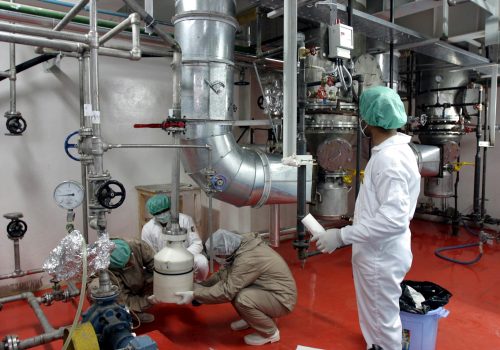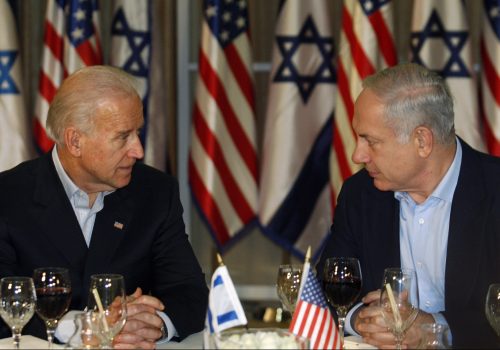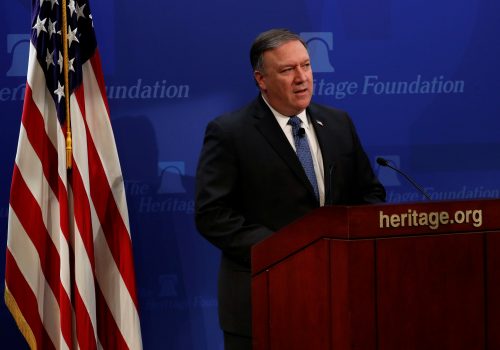Pompeo’s attempted dismantlement of the Iran nuclear deal
Like almost every other aspect of the Trump administration’s Iran policy, Secretary of State Mike Pompeo’s stated justification on May 27 for ending remaining waivers for civil nuclear cooperation with Tehran was more public relations than reality. Contrary to his press statement, baldly labeled “Keeping the World Safe From Iran’s Nuclear Program,” ending the waivers will make the region and the world less safe. The only purpose is to finally kill the 2015 Iran nuclear deal before President Donald Trump’s term ends.
All three of the peaceful cooperation activities that are now rendered illegal under US law reinforced the non-proliferation benefits of the Joint Comprehensive Plan of Action (JCPOA). Converting the Arak research reactor so it cannot produce more than miniscule amounts of weapons-grade plutonium closes off a potential pathway to nuclear weapons. Allowing the import of near-20 percent enriched uranium fuel for the Tehran Research Reactor (TRR) means Iran has no reason to enrich uranium to that level. Facilitating the export of Iran’s spent and scrap research reactor fuel removes any potential for this fuel to be reprocessed or converted for weapons use in the future.
Contrary to Pompeo’s statement, far from being “proliferation sensitive,” these activities protect against nuclear proliferation. Pragmatists in the administration who understood this were able to prevail in internal policy disputes the past two years. Now, the Pompeo-led uber hawks are dominant. Hence, in sixty days, all foreign entities working on these projects, including the China National Nuclear Corporation, will be subject to penalties if they continue cooperation with Iran.
Pompeo has handed Tehran a perfect excuse to resume nuclear activities of proliferation concern. The Arak reactor is a medium-term problem—it would take, perhaps, two years to complete the reactor in its original design, allowing production of up to fourteen kilograms of weapons-grade plutonium a year, which is enough for one to two warheads. But, once the effort to convert it to a proliferation-resistant design ends, it will be much harder to persuade Iran to give up the dangerous design, again, in the future.
Cutting off Iran’s supply of 19.75 percent enriched fuel for the TRR is a near-term problem. Iran’s enrichment to that level in early 2010 sharply escalated the growing nuclear crisis at the time. Iran’s stated rationale was to replenish fuel for the TRR, which was used to produce medical isotopes to treat cancer patients, but, when uranium is enriched to 20 percent, it becomes weapons usable. The near-20 percent enrichment was the theme of Israeli Prime Minister Benjamin Netanyahu’s “redline” speech at the United Nations in 2012, where he foreshadowed the threat of an Israeli military strike against Iran.
Suspending near-20 percent enrichment was a signal achievement of the 2013 Joint Plan of Action agreement that set the stage for the JCPOA. The 2015 deal, then, continued this suspension for fifteen years and required the existing stockpile to be down-blended or sold.
How soon Iran would need to enrich uranium to 19.05 percent for fuel for the TRR is uncertain and contentious. Iran receives TRR fuel from Russia in 5kg installments and, probably, has enough partially fabricated fuel plates to last for some time. The TRR has often operated intermittently. Yet, Iran contends that medical isotope production operations continue daily, and could claim that the uncertainly created by Pompeo’s May 27 announcement makes it prudent to begin enriching on its own in order to ensure that there is no disruption to reactor operations.
Giving Iran this excuse hardly makes the world “safe,” as Pompeo has claimed. The truth is the opposite. Iran has not succumbed to any of the fantastical demands Pompeo laid out two years ago. Instead, US withdrawal from the JCPOA goaded Iran into exceeding most of the nuclear limits in the deal, thereby halving the time it would take to produce a weapon’s worth of highly enriched uranium.
Pompeo’s latest move has the same purpose—to goad Iran into taking further steps that can be castigated as provocative and contribute to snapback UN sanctions. While Iran may well continue to try to wait things out until the US presidential election in November, the Trump administration wants to kill off the JCPOA before then. When asked in a May 14 interview about Democratic Party presumptive presidential candidate Joe Biden seeking to revive the JCPOA, Special Representative for Iran Brian Hook boasted that there would not be much left of it to rejoin. It is a scorched earth policy.
Trump and Pompeo claim that their goal is to pressure Iran into renegotiating a new, “better” deal. But they show little interest and even less aptitude in actually negotiating with Tehran. Putting Iranian Foreign Minister Javad Zarif on the Treasury blacklist certainly was not an action intended to further prospects for talks. Neither was assassinating Quds Force commander Qasem Soleimani. Nor has the Trump team made any observable effort to bring European partners to its side in prospective bargaining.
As Speaker of the US House of Representatives Sam Rayburn said, “any jackass can kick down a barn, but it takes a good carpenter to build one.” The Trump administration is good at kicking down the JCPOA barn. They know nothing about carpentry.
Mark Fitzpatrick is an associate fellow at the International Institute for Strategic Studies. Before IISS, he had a 26-year career in the US Department of State, including as Deputy Assistant Secretary for Non-Proliferation (acting). Follow him on Twitter: @MarkTFitz.
Image: U.S. Secretary of State Mike Pompeo speaks during the United Against Nuclear Iran Summit on the sidelines of the United Nations General Assembly in New York City, U.S. September 25, 2019. REUTERS/Darren Ornitz


